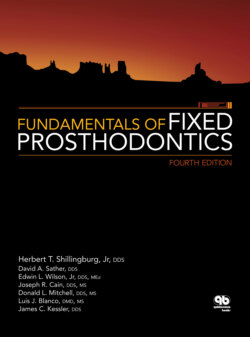Читать книгу Fundamentals of Fixed Prosthodontics - James C. Kessler - Страница 81
На сайте Литреса книга снята с продажи.
Setting condylar guidance
ОглавлениеWax lateral or protrusive interocclusal records are used for setting the condylar inclination of this instrument. Note that when lateral interocclusal records are employed, the left record is used for the right condylar inclination and the right record for the left condylar inclination. The thumb nut is loosened at the rear of each condylar track mechanism so that it can be easily rotated. At this time, however, the condylar inclination should be left at 30 degrees. The incisal guide pin should still be raised out of contact with the incisal table.
The right interocclusal record is seated on the teeth of the mandibular cast. The upper member of the articulator is gently lowered until the maxillary teeth engage the wax record. The left condylar guide is adjusted by changing the condylar inclination with the thumb nut located at the rear of the guide. The teeth on the right side of the cast will rock in and out of the record. If the condylar path is too shallow, the anterior teeth will be drawn out of the wax record (Fig 5-68a). When the path becomes too steep, the posterior teeth become unseated (Fig 5-68b). The correct condylar inclination has been determined when the cast is seated completely in the wax record (Fig 5-68c). The nut at the rear of the condylar guide is tightened.
The thumb nut on the top of each condylar guide of the articulator is loosened. The Bennett angle ring is slowly rotated outward (from 30 toward 0 degrees) until the flat side on the outer aspect of the condylar ball contacts the inner surface of the sleeve on the condylar shaft, forming brassto- brass contact (Fig 5-69). This process is repeated on the right side.
If a protrusive interocclusal wax record is used to establish the condylar inclination, both condylar mechanisms are rotated simultaneously in the same manner described above for setting each condylar inclination separately. In this situation, the angle of mandibular lateral translation (L) is esti- mated by use of the Hanau formula: L = H/8 + 12, where H is the condylar protrusive inclination. Because a change in condylar inclination from 20 to 50 degrees would produce less than a 4-degree change in the Bennett angle by this calculation, placing the Bennett angle ring at an arbitrary 15-degree angle would produce minimal error.
Fig 5-68 When using a protrusive interocclusal record to set the condylar guidance, the condylar inclination is rocked up and down. (a) When the angle is too shallow, the anterior teeth lift out of the record. (b) When the inclination is too steep, the posterior teeth lift out. (c) When the cast is completely seated, the inclination is correct.
Fig 5-69 (a) With the casts seated in a lateral interocclusal record, there is a gap between the condyle and sleeve. (b) When the Bennett angle ring (and condylar track mechanism) are rotated, the condyle contacts the sleeve. The number on the scale is the angle of the lateral translation.
The condylar inclinations are entered in the patient’s record. The amount of condylar inclination for each condyle is written on the corresponding side of the cast. When teeth are prepared at a future time, it will not be necessary to make new interocclusal records to adjust the articulator. The settings developed during the diagnostic mounting can be reused.
Fig 5-70 The incisal guide pin is raised 1.0 mm off the guide block.
Fig 5-71 Tray resin is placed on the incisal block.
Fig 5-72 The guide pin is closed into the soft resin.
Fig 5-73 The casts are moved through all excursions.
Fig 5-74 There is a custom anterior guidance record on the guide block.
